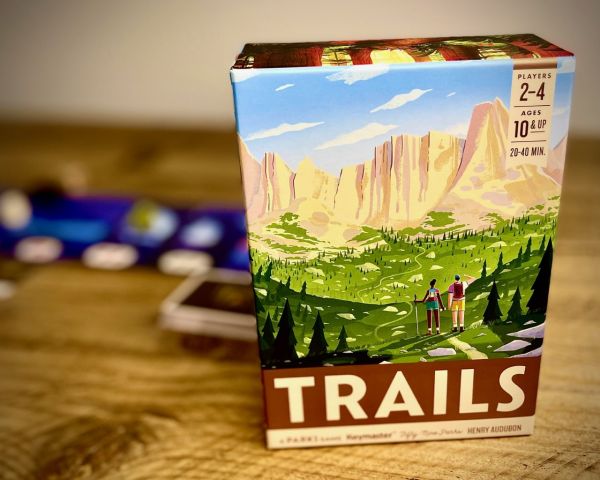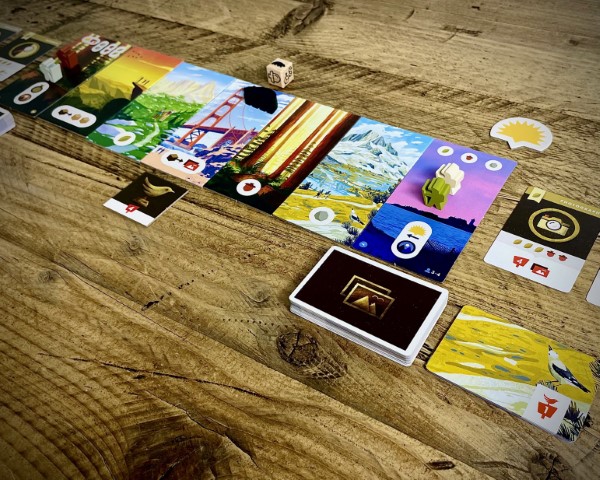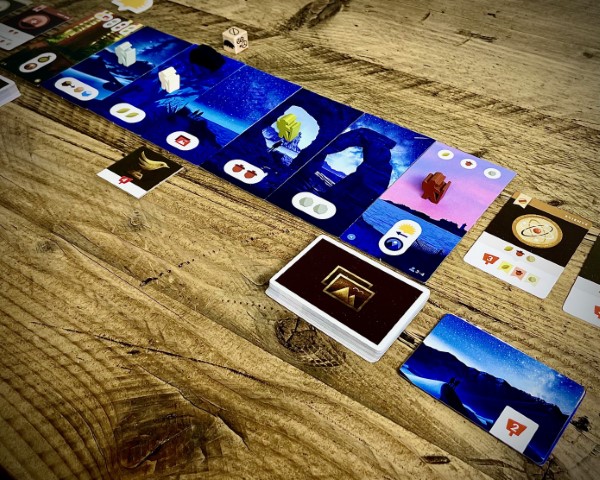Experience the Great Outdoors in Trails: A Parks Game

Welcome to Trails, a game of hiking while gathering resources, earning badges, taking pictures, and birdwatching.
Trails is a quick and simple card drafting game for 2-4 players. Compete to collect from a limited pool of Wilderness Badges, spot the largest number of Birds, and take the most valuable Photos.
Players hike back and forth along a Trail of sites and national parks while the Sun sets, revealing new rewards and discoveries. Gather acorns, leaves, and rocks as valuable resources during your journey. Stop at the right spot to take pictures. Push your luck to encounter Wildlife and gain bonuses. And finally, exchange resources for Badges at the beginning and end of the Trail.

Gameplay
During setup, a series of seven tiles represent the Trail. The first tile is the Trailhead, placed to the left of the Trail. Then, five site tiles portray iconic sites or national parks across the U.S. Finally, the Trail End is the last tile to the right of the Trail.
Setup the game as follows:
- Place the Sun above the right-most icon on top of the Trail End tile;
- Shuffle and place the Badge and Photo decks under the Trailhead and the Trail End, respectively.
- Place rock, acorns, and leaves resource cubes under their respective site tiles.
- Place the Wildlife bear token and dice above the middle trail tile.
- Place the Bird Trophy below the Photo tile.
- Draw two Badge cards and arrange them before the Trailhead and another two after the Trail End.
- Place hikers on the Trailhead to begin their journey.
- In a four-player game, place two hikers at the Trailhead and the other two at the Trail End.
- Each player draws a card and gets a Canteen.
The objective of the game is to score the maximum number of points. There are three ways of scoring points: Badges, Photos, and the Bird Trophy.
You can spot Birds on Badges and Photos. The player who spots the largest number of Birds at the end of the game wins the Bird Trophy.
Each site tile has an icon on the bottom representing the Actions players can take when visiting the site. Actions can be gathering acorns, leaves, and rocks as resources, paying a resource to take a Photo, or swapping one resource for another two resources of the same given type. After sunset, tiles flip to their night side, revealing more powerful Actions. At night players can gather twice the number of resources, take a "Photo for free", or swap a resource for another two of a different type.
Players move one or two site tiles per turn. You can take the tile Action but cannot accumulate more than eight resources concurrently. You must stop at the beginning and end of the Trail, where you can earn up to the two location Badges plus the one from your hand. Badges cost a combination of resources, give you points, can have Birds, and may have a Bonus Action. When you earn a Badge, place it facing upwards in front of you and take its Bonus Action if it applies. Some bonus Actions are resolved at the game's end when players compute points. At the end of the player's turn, replace all earned Badges. If you acquired the Badge from your hand, replace it with a new one.
Players race against each other to gather enough resources and reach the Trailhead or the Trail End first to collect desired Badges before the other players. Instead of moving up to a couple of tiles per turn, you may use a filled Canteen to jump ahead any number of tiles in the direction you are facing. That may allow you to speed forward, gaining an advantage over competitors and strategically guaranteeing that you will earn the Badges you want to collect. Once the Canteen is empty, you cannot use it until you reach the Trailhead, where it gets refilled.

A hike wouldn't be complete without photography, would it? In Trails, Photos award you points and allow you to spot Birds.
When you take a Photo, you can either draw two cards from the Photos deck, choose and keep one and discard the other, or choose the Photo on top of the discard pile. If you run out of Photo cards, flip the Photos discard pile without shuffling it.
Keep your photos hidden until the end of the game. At the end of the game, you will reveal your Photos and compute their points and Birds.
Trails introduce two interesting mechanisms to liven up the gameplay: Wildlife and the Sun.
Encountering Wildlife is represented by a bear token that moves between tiles based on results from rolling the Wildlife dice. When you enter a tile with the bear token, you can take the tile action, roll the Wildlife dice, move the bear to the tile in which the action matches the dice result, and you can also take that action. If the dice roll result is a bear, you choose where to place the bear token next.
The Sun sets during the game and determines the end of the game when it reaches its final placement. Every time a player arrives at the Trail End, you can gain the bonus the Sun is pointing to; if it is pointing to a tile, you can take that tile action. Then, move the Sun towards the beginning of the Trail. If the Sun moves off a tile, flip the tile to its night side while keeping hikers and Wildlife over it. The Trailhead and Trail End tiles do not flip. When the Sun points to the last leftmost spot of the Sun track and a hiker reaches the Trail End, the player takes a picture and places the Sun in front of its photos. The last round for all other players is triggered, and Sun bonuses no longer apply. The game ends when the player to the left of the hiker with the Sun plays. It is time to compute points.
The player, or players, with the most Birds, gain the Bird Trophy.
Points are scored based on the Wilderness Badges, Photos, and the Bird Trophy. The player with the highest number of points wins the game.
If there is a tie, the tiebreakers are having the most Badge cards, followed by the most Photo cards, and finally the most Birds. If there is still a tie, players share the victory.

Review
Trails follows the heritage of the best-selling Parks series, a hard one to beat. Indeed, most players prefer Parks, which does not diminish Trails' worth.
The first thing that catches one's attention in Trails is the incredible detail given to the artwork. The tiles, cards, and box are stunning. Component quality varies: thick cardboard is used to make Trail tiles, the Sun, and Canteens; cards' are standard; while resources are simple wooden cubes that do not strike out, the hikers and bear wooden tokens are lovely.
Trails is a fantastic gateway game, easy to teach and learn, and great for introducing new players to hobby board games. It's a small game you can pack into your bag and propose a match to any group of friends, at any time, effortlessly; great entertainment guaranteed.
Even though most game rules are simple to learn and follow, one minor complexity is the sunsetting mechanism, which can confuse first-time players. However, it becomes natural after playing the game a couple of times.
The game plays excellent from two to four players, and more players do not mean long waiting periods. Rounds are quick and engaging, with every player fully absorbed in the expectation of how others will play.
Apart from four-player games where hikers start on both ends of the Trail, Players start the game under the same conditions with a slight advantage based on playing order. The first players to reach Trail beginning and end tiles have a better chance of obtaining their chosen Badges. The only element of luck in the game is the Wildlife encounter and rolling the Wildlife dice. Hence, the game outcome relies heavily on players' tactical decisions.
However, turn choices are limited to the following: As you move, you can skip a tile; you can use the Canteen to get ahead of competitors and guarantee your desired Badge; you can choose to take a tile action or not, like not taking a Photo to avoid spending a resource; you can decide how to swap resources if that is the action you are playing; if you gather more than eight resources you must choose which ones to discard;
The more you play the game, the more the same pattern emerges: move, act, gather, earn and collect, rinse and repeat, rinse and repeat. The pool of Badge cards to draft is so tiny that it forces players to compete for the same cards, with no strategic choices involved. The Badge cards have no engine-building mechanics, which would add some flavor to the game and lessen its repetitive nature.
Final Thoughts
Trails is definitely a fun game, easy to pick up and play with little commitment and simple mechanics. Replayability is questionable, though. It may end up being lost on your game shelf and replaced by games with more diversity, complexity, or simply more exciting to play in the longer run.
Outstanding artwork and components, low complexity, medium replayability, and great player interaction. Unfortunately, Trails fails to achieve all the merits of Parks, its predecessor, and I would recommend playing Parks instead of Trails if you are looking for a “Parks experience.”
Pros:
- Simple and easy to pick, teach, learn, and play.
- Stunning artwork.
- If you love Parks, the publisher describes Trails: a Parks Game as a standalone adventure in the Parks series.
Cons:
- A fantastic gateway game that may not appeal to hobbyists.
- Mechanics can quickly become lather, rinse and repeat.
- Lack of excitement in the longer run.
Note: This article is provided by Roll & Mind.







